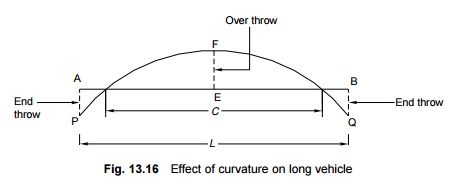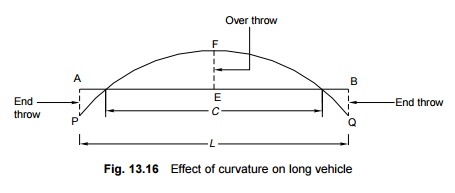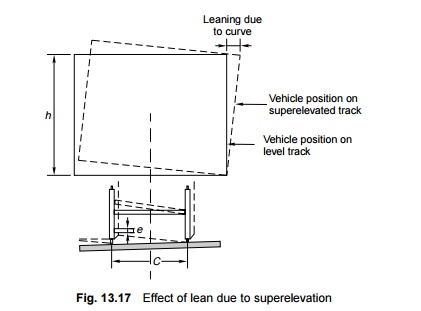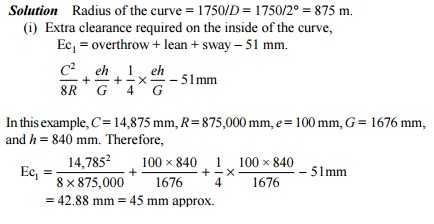Chapter: Civil : Railway Airport Harbour Engineering : Railway Engineering : Curves and Superelevation
Railway Engineering: Extra Clearance on Curves

Extra Clearance on Curves
Extra clearances are provided on
horizontal curves keeping the following considerations in mind.
Effect of curvature
When a vehicle negotiates a
horizontal curve, its frame does not follow the path of the curve, since, being
a rigid structure, it is unable to bend. The vehicle, therefore, projects towards
the inside of the curve at its central point and toward the outside of the
curve near its ends. The distance by which the longitudinal axis of the body of
vehicle moves out from the central line of the track is the extra clearance
required (Fig. 13.16).

(i) The extra
clearance required at the centre of the vehicle, which projects towards the
inside of the curve, is called overthrow and is given by the equation
EF = C2 /8R
(ii) The extra clearance required
at the ends of the vehicle, which project towards the outside of the curve, is
called end-throw and is given by the equation
AP or BQ = L2 - C 2 / 8R
where L is the length of the vehicle, C is the
centre-to-centre distance between the bogies and R is the radius of the
curve.
Effect of leaning due to superelevation
On account of the superelevation
provided on a curve, the vehicle leans towards the inside of the curve, thereby
requiring extra clearance as shown in Fig. 13.17. The extra clearance required
for leaning is as follows:
Lean = he/G
where h is the height of
the vehicle, e is the superelevation, and G is the gauge.
In case the superelevation is not
known, it is suggested that its value be assumed to be 70 mm up to a 1 o curve
and 115 mm for curves above 1 o . No extra clearance, however, is required for
leaning on the outside of the curve.

Effect of sway of vehicles
On account of unbalanced
centrifugal forces caused due to cant deficiency or cant excess, the vehicles
tend of experience an additional sway. The extra clearance required on the
inside of the curve due to the sway is taken as one-fourth of the clearance
necessary due to leaning.
On summarizing, the total extra
clearance (in mm) required on curves is as follows:
(i)
Extra clearance inside the curve = overthrow +
lean + sway

(ii)
Extra clearance outside the curve = end-throw

where C is the centre-to-centre distance between
bogies, which is 14,785 mm for BG routes and 13,715 mm for MG routes, R
is the radius of the curve in mm, L is the length of a bogie, which is
21,340 mm for BG routes and 19,510 mm for MG routes, e is the
superelevation in mm, h is the height of the vehicle, which is 3350 mm
for BG tracks and 3200 mm for MG tracks, and G is the gauge, which is
1676 mm for BG tracks and 1000 mm for MG tracks.
The empirical formulae normally adopted in the field for
determining the extra clearance due to the curvature effect are as follows:
BG MG
Overthrow
(mm) 27,330/R 23,516/R
End-throw
(mm) 29,600/R 24,063/R
These empirical formulae are
based on standard BG and MG bogie lengths and the value of R is in metres.
1 Extra Clearance Required in Various
Situations
This section discusses the extra
clearances required in different situations with regard to the track and the
platform.
Between adjacent and curved tracks
In this case, the lean will not
be taken into consideration, as both the tracks will have almost the same
superelevation. The extra clearance required in this case will be the sum of
the clearances required on the inside and the outside of the curve as follows:
Ec = (Ec1
- lean) + Ec 2
=
Overthrow + sway + end-throw

where e is the
superelevation in mm, h is the height of the vehicle (3.35 m for BG and
3.2 m for MG), and G is the gauge.
For adjacent tracks with structures in
between
When there is a structure between
two adjacent tracks, each track is treated independently and extra clearances
are provided by considering each track with respect to the structure.
For platforms
In the case of platforms, it has
been observed that the provision of extra clearance on curves as discussed may
lead to excessive gap between the footboard and the platform. It is, therefore,
stipulated that next to platforms this extra clearance be reduced by 51 mm (2
in.) on the inside of the curve and 25 mm (1 in.) on the outside of the curve.
Example 13.7 Two
high-level platforms are to be provided on the inside as well as the
outside of a 2 o curve on a BG track with a superelevation of 100 mm. What
should the required extra clearances for these platforms, both on the inside
and the outside of the curve, be? (Length of bogie = 21,340 mm, c/c bogie
distance = 14,785 mm, height of platform = 840 mm.)
Solution Radius of the curve = 1750/D
= 1750/2 o = 875 m.
(i)
Extra clearance required on the inside of the
curve, Ec1 = overthrow + lean + sway - 51 mm.

(ii)
Extra clearance required on the outside of the
curve,

Therefore, an extra clearance of
45 mm should be provided for the outside platform on the inner side of the
curve and of 10 mm for the inside platform on the outer side of the curve.
Related Topics